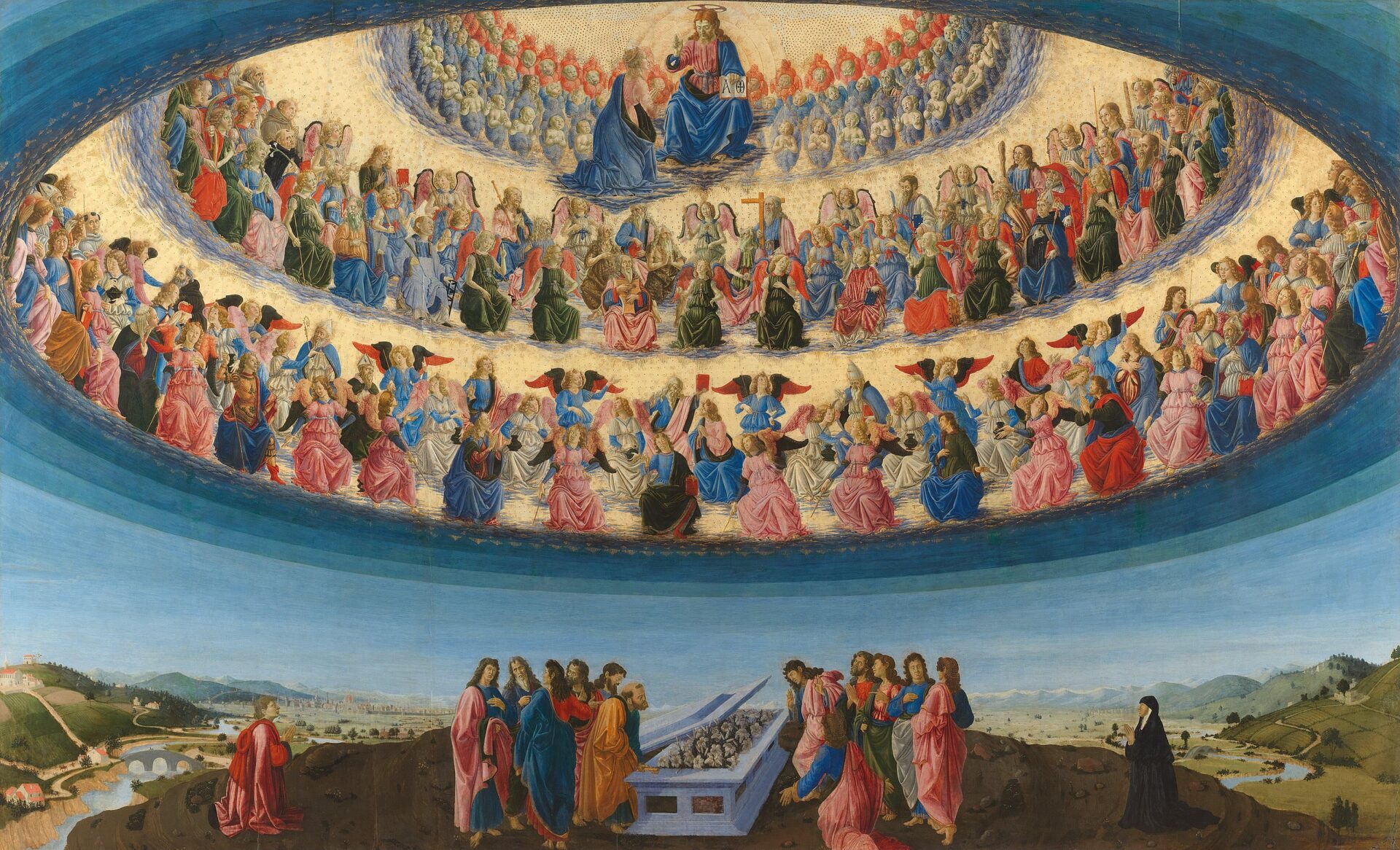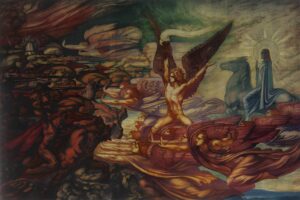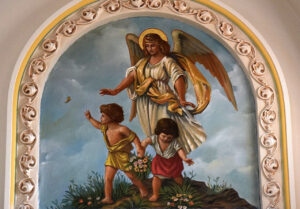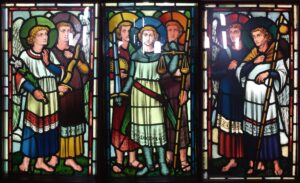Featured image: The Assumption of the Virgin showing the three triads and nine choirs of angels. Francesco Botticini, Public domain, via Wikimedia Commons
Key Takeaways
- The nine choirs of angels form a structured hierarchy in Christian theology, each choir with unique roles and proximity to the divine.
- This hierarchy, divided into three triads, reflects levels of contemplation, cosmic governance, and interaction with humanity.
- Influential early Christian thinkers like Pseudo-Dionysius and Thomas Aquinas shaped our understanding of these angelic orders.
- The highest triad—Seraphim, Cherubim, and Thrones—focuses on the pure adoration and contemplation of the divine.
- The middle triad—Dominions, Virtues, and Powers—administers divine order across the cosmos and protects against chaos.
- The final triad—Principalities, Archangels, and Angels—directly influences humanity, guiding and protecting individuals and nations.
- The angelic hierarchy parallels structures in other world mythologies, showing universal themes of cosmic order and divine mediation.
Within the tapestry of Christian mythology, angels occupy a unique position as spiritual beings bridging human experience and the divine. For centuries, believers, scholars, and artists have portrayed angels as messengers, guardians, and participants in God’s cosmic order. One of the most influential concepts shaping the understanding of these beings is the idea of a structured angelic hierarchy—often referred to as the “nine choirs of angels.” This framework organizes angels into distinct orders or choirs, each associated with particular roles, attributes, and symbolic meanings.
These nine choirs are not explicitly described in the Bible. Instead, they emerged from centuries of theological reflection, early Christian mysticism, and scholarly commentary. The figure best known for popularizing this model is Pseudo-Dionysius the Areopagite, a 5th-century Christian writer who combined biblical references, philosophical ideas, and Neoplatonic thought to arrange angelic beings into a grand cosmic order. Later, influential theologians such as Thomas Aquinas expanded and systematized this hierarchy, weaving it into the broader fabric of Christian theology.
Today, discussions of the nine choirs transcend purely religious audiences. They appear in art, literature, music, and academic studies that explore their meaning as cultural symbols. |The nine choirs can be examined as a product of human imagination and theological creativity, offering insights into how early Christian thinkers envisioned the spiritual cosmos and humanity’s place within it.
In this article, we will explore the origins and structure of the nine choirs, examine each choir’s characteristics and symbolic significance, and consider how this angelic hierarchy influenced art, literature, and cultural thought. We will also look at how mystics, scholars, and everyday believers interpreted these beings, and how their stories continue to inspire reflection on order, virtue, and the mysteries of existence.
Table of Contents
The Origins of the Angelic Hierarchy
Early Influences and Non-Biblical Roots
While angels appear throughout the Hebrew Bible and the New Testament, these texts do not present a fully developed angelic hierarchy. Instead, angels emerge as messengers, protectors, and agents of divine action. The idea of ranking and ordering angels developed later, influenced by early Christian thinkers who engaged with various philosophical and religious traditions. Contacts with Hellenistic thought, Neoplatonism, and earlier Jewish traditions, as well as the adaptation of Greco-Roman philosophical frameworks, shaped how Christian authors understood spiritual reality.
Pseudo-Dionysius the Areopagite
A key figure in formalizing the nine choirs is Pseudo-Dionysius the Areopagite. Writing in the late 5th or early 6th century, this anonymous author produced works that blended Christian theology with philosophical ideas drawn from late antiquity. In his text The Celestial Hierarchy, Pseudo-Dionysius proposed that angels are arranged in three triads of three choirs each. He saw this structure as a reflection of divine order—a cosmic ladder through which divine illumination passes from higher, more transcendent beings to those closer to humanity.
Thomas Aquinas and Systematic Theology
Centuries later, the influential medieval theologian Thomas Aquinas integrated Dionysian angelology into his Summa Theologica. Aquinas refined these concepts, linking each choir’s characteristics to biblical references and theological principles. He treated the angelic hierarchy as both a spiritual reality and a model for understanding the interplay between divine will and the created world. Under Aquinas and other scholastic thinkers, the nine choirs became an accepted framework within Christian theology, influencing how believers imagined the invisible orders of heaven.
Cultural and Artistic Resonance
As the notion of nine choirs gained traction in theological thought, it also permeated art, literature, and popular religious practice. Medieval and Renaissance artists depicted angels in elaborate religious paintings, mosaics, and icons, sometimes including subtle references to their hierarchical status. Poets, mystics, and dramatists invoked these angelic beings, using their attributes to comment on moral order, divine justice, and the human quest for salvation. Over time, the nine choirs became a shared cultural reference point—an imaginative map of the heavens that offered guidance, comfort, and awe.

The Structure of the Nine Choirs of Angels
The nine choirs are commonly divided into three triads, each comprising three orders. The first triad—Seraphim, Cherubim, and Thrones—stands closest to the divine source. The second triad—Dominions, Virtues, and Powers—manages cosmic order and ensures that divine plans unfold in the universe. The final triad—Principalities, Archangels, and Angels—connects directly with humanity, guiding nations, communities, and individuals.
This three-tiered arrangement suggests a flow of divine illumination and authority. The highest choirs receive knowledge and love directly from God, passing this divine influence downward. Mid-level choirs translate that influence into principles that govern creation, while the lowest choirs interact with the human world, relaying messages, offering protection, and guiding moral choices.
This hierarchy reflects how ancient and medieval thinkers structured their understanding of existence. It provides a metaphor for order, layered reality, and the idea that everything in the cosmos, from the grandest principle to the smallest detail, participates in a divine pattern.
The Nine Choirs of Angels Hierarchy
First Triad
- 🔥 Seraphim
- 💎 Cherubim
- ⚖️ Thrones
Second Triad
- 👑 Dominions
- ✨ Virtues
- 🛡️ Powers
Third Triad
- 🏰 Principalities
- 📯 Archangels
- 🌟 Angels
First Triad
- 🔥 Seraphim
- 💎 Cherubim
- ⚖️ Thrones
Second Triad
- 👑 Dominions
- ✨ Virtues
- 🛡️ Powers
Third Triad
- 🏰 Principalities
- 📯 Archangels
- 🌟 Angels
The First Triad: The Angels Closest to the Divine Essence
Seraphim
In this model, the Seraphim are the loftiest beings, dwelling closest to the divine presence. The name “Seraphim” likely derives from a Hebrew root meaning “to burn,” suggesting their intense, fiery devotion. Biblical texts like Isaiah 6:2–3 describe Seraphim as six-winged creatures eternally chanting “Holy, holy, holy” before God’s throne. For theologians, these beings personify pure love, continuous worship, and the intensity of divine illumination.
Symbolism: Seraphim represent the purest form of spiritual aspiration. They evoke the idea that at the highest level of existence, reality is sustained by ecstatic recognition of the divine. Seraphim are symbols of idealized virtues—perfect love, purity, and enlightenment—that transcend mundane concerns.
Cherubim
Cherubim often appear in scriptural and theological writings as guardians of divine knowledge and mystery. Contrary to later popular depictions of cherubs as chubby infants, the Cherubim in biblical and early Christian sources are formidable beings. They guard sacred spaces, embodying deep wisdom and insight. In Genesis, Cherubim protect the entrance to Eden after the fall of humanity; in the visions of Ezekiel, they appear as complex, multi-faced figures supporting the throne of God.
Symbolism: Cherubim symbolize knowledge, contemplation, and reverence. Their presence suggests that ultimate reality is complex, multi-layered, and worthy of awe. They might represent the human quest to understand the mysteries of existence, the complexity of creation, and the pursuit of knowledge that surpasses ordinary understanding.
Thrones
The Thrones, sometimes identified with the Hebrew term “Ophanim,” are associated with divine justice, order, and humility. They are often portrayed as shining wheels covered with eyes, as found in Ezekiel’s vision (Ezekiel 1:15–21). This imagery suggests stability, insight, and unshakable resolve. Thrones serve as conduits for divine judgment and the establishment of cosmic harmony.
Symbolism: Thrones signify balance, fairness, and the principle that beyond the changing world lies an unalterable moral structure. They can be seen as reminders that justice and moral integrity stand at the core of any well-ordered system—a belief that ultimate truths guide all lesser forms of authority.
The Second Triad: Governing Creation and Cosmic Order
Dominions
The Dominions (or Lordships) oversee the duties of the lower choirs and ensure that everything in the cosmos aligns with divine will. While scripture does not describe them in detail, their name conveys rulership and authority. They channel the insights of the higher choirs into actionable governance.
Symbolism: Dominions represent leadership, structured governance, and the principle of order. In a broader cultural context, they mirror the human need for principled leadership and the understanding that well-functioning systems rely on wise oversight. They remind us that true authority should guide, not oppress, and should reflect values greater than personal gain
Virtues
The Virtues, sometimes called the “Spirits of Motion,” are associated with divine energy and the unfolding of miracles. They ensure the vitality and endurance of physical and spiritual phenomena, channeling divine strength into the world. Although references to them in scripture are indirect, their attributes align with notions of moral strength, courage, and the capacity to inspire heroic deeds.
Symbolism: Virtues reflect the idea that extraordinary achievements—be they moral, artistic, or scientific—emerge from a source of inspiration beyond ordinary human effort. They encourage the belief that humanity can tap into greater forces to overcome obstacles, create beauty, and shape a better future.
Powers
Powers, sometimes described as warrior angels, maintain the balance of good in the universe and guard against the infiltration of chaos and evil. They are defenders of moral and spiritual order, ensuring that the cosmic equilibrium remains intact. In Ephesians 6:12, “powers” appear as part of a list of spiritual forces, underscoring their role in the ongoing conflict between good and evil.
Symbolism: Powers represent protection, vigilant watchfulness, and a moral defense mechanism that prevents corruption. They are allegories for the ethical frameworks that keep societies stable—laws, principles, and moral teachings that prevent descent into disorder.
The Third Triad: Angels in Human Affairs
Principalities
Principalities (or Princes) influence larger communities, nations, and organizational structures. They guide social and political leaders, encouraging wisdom and justice. While details are sparse in scripture, their name implies a broad supervisory role, suggesting that human institutions, at their best, reflect higher ideals.
Symbolism: On a cultural level, Principalities embody the hope that moral values can shape governance and societal structures. They remind readers that ethical leadership, sound policies, and attention to the common good are essential for collective well-being. Even outside a religious framework, Principalities symbolize the possibility that higher moral principles can shape historical events.
Archangels
Archangels stand as some of the most recognized figures in Christian angelology. They are the heralds of major announcements and agents of significant interventions in human affairs. The Bible names Archangels such as Michael—associated with protection and justice—and Gabriel, known for delivering important messages (as in Luke’s account of the Annunciation to Mary). Raphael appears in the Book of Tobit as a guide and healer.
Symbolism: Culturally, Archangels represent communication, moral guidance, and transformative change. They symbolize the idea that at critical junctures, higher insights can appear, guiding individuals or communities. Archangels can be seen as personifications of moral courage, compassionate service, and messages that galvanize societies toward truth and goodness.
Angels
The final and most familiar choir is simply known as Angels. They are closest to human life, often described as guardians and protectors who watch over individuals. The concept of guardian angels—entities assigned to protect and guide each person—resonates strongly with popular devotion. References to these protective figures appear in the Christian scriptures, such as Matthew 18:10, where Jesus mentions angels who stand before God, implicitly advocating on behalf of children.
Symbolism: Angels, in the broad sense, symbolize divine care, guidance, and intimate involvement in human affairs. They represent the idea that each person’s life matters and that moral and ethical insights can arise in everyday moments. They stand for hope, solace, and the belief that goodness can assist those in need.
Significance of the Nine Choirs in Christian Mythology
Divine Order and Cosmic Harmony
The hierarchical arrangement of angels is not purely about authority—it embodies a vision of universal harmony. Each choir represents a facet of existence, from the intense spiritual love of the Seraphim to the direct interaction of Angels with individuals. This structure suggests that the cosmos functions as a grand, interrelated system, where every level has a purpose.
The structure is also a metaphor for how human cultures have historically sought to understand the complexity of life. The nine choirs illustrate a worldview where every phenomenon has meaning, every actor has a role, and all layers of reality fit together coherently.
The Flow of Divine Influence
The angelic hierarchy also reflects a theory of how divine grace or spiritual insight flows from higher levels of being to lower ones. The Seraphim, contemplating the essence of divinity, share their enlightenment with Cherubim and Thrones, who then transmit principles of knowledge and justice to the Dominions, Virtues, and Powers. Finally, these mid-level choirs guide the Principalities, Archangels, and Angels, who interact with humanity.
This descending chain of illumination suggests that moral and spiritual growth involves receiving wisdom from higher sources, then passing it on to shape individual lives and communities. In non-religious terms, this can be interpreted as a model for how inspiration, ideals, and moral values circulate within a culture, influencing decisions, institutions, and personal conduct.
Humanity’s Relationship with the Angelic Hierarchy
The lowest triad—Principalities, Archangels, and Angels—connects directly with human societies and individuals. Their involvement underscores the belief that divine care extends into the ordinary world. Archangels announce pivotal events, angels guard personal destinies, and Principalities influence nations.
Even those who do not hold religious beliefs can appreciate this motif as a narrative device that brings grand metaphysical concepts closer to human experience. This part of the hierarchy humanizes the cosmic picture, suggesting that grand principles of justice, knowledge, and love eventually become relevant at a personal scale.
The Nine Choirs in Art, Literature, and Culture
Medieval and Renaissance Art
Throughout the Middle Ages and the Renaissance, artists drew on these angelic concepts to enhance religious paintings, illuminated manuscripts, and church architecture. Angels of higher choirs often appeared as abstract, awe-inspiring beings, sometimes depicted as wheels or creatures with multiple wings and eyes. Lower choirs took on more humanized forms, allowing viewers to identify with their protective or guiding roles.
This artistic tradition influenced cultural aesthetics, symbolism, and even moral education. By visualizing angels in hierarchical forms, artists reinforced the idea of a structured cosmos and helped believers imagine the unseen spiritual world.
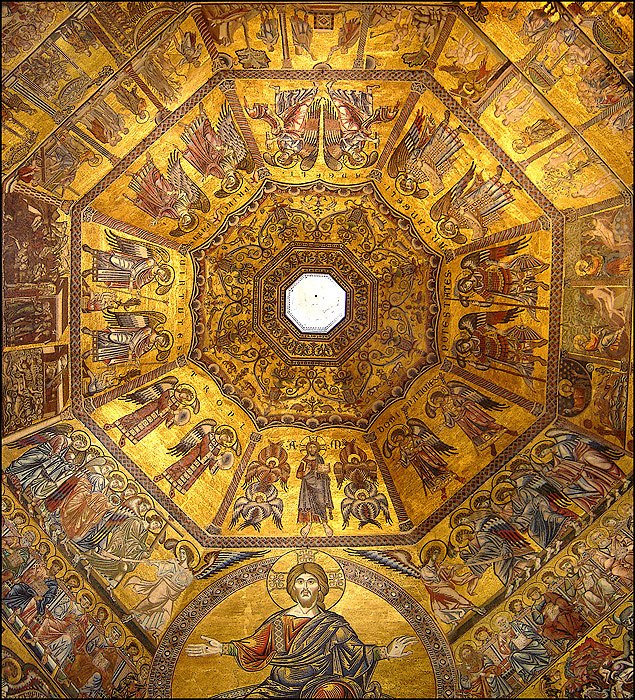
Literary Expressions
Poets, mystics, and authors throughout Christian history referenced the nine choirs in their works. For example, Dante Alighieri’s Divine Comedy integrates angels into its cosmological scheme. While Dante does not strictly follow Dionysius’s classification, he employs a hierarchical vision that resonates with the nine choirs’ logic—portraying a universe ordered by divine intelligence and filled with spiritual intermediaries.
Mystical writers interpreted these choirs as stages of spiritual ascent. By meditating on the attributes of each choir, believers might aspire to emulate their virtues, progressing from love and wisdom to justice, governance, and finally, compassionate engagement with human life. The texts offer also a window into historical attempts to understand the moral and spiritual growth of individuals and communities.
Modern Cultural References
Contemporary popular culture still references angels, though usually in more simplified forms. Films, novels, and television shows often feature angels as helpful guardians or inspirational messengers, distilling centuries of theological thought into accessible stories. While these modern representations rarely delve into the complexity of the nine choirs, they maintain a link to the older traditions by preserving the idea that angels represent kindness, guidance, and hope.
Mystical and Contemplative Dimensions
Spiritual Growth and Inner Life
In addition to serving as an organizational schema for the spiritual cosmos, the nine choirs have played a role in Christian spirituality and mysticism. Some mystical traditions interpret the hierarchy as a roadmap for personal transformation. The contemplative individual aspires to move through analogous levels of virtue and understanding, gradually refining their love, insight, and moral conduct.
This can be understood as a metaphor for self-improvement. Each triad can represent a step in the maturation of the human person: developing deep compassion and reverence (first triad), cultivating order and moral strength (second triad), and finally extending care and wisdom into everyday life (third triad).
The Angelic Hierarchy as Moral Allegory
The nine choirs constitute an elaborate moral allegory. The Seraphim’s pure love, Cherubim’s wisdom, and Thrones’ justice become ideals to strive for. Dominions’ governance, Virtues’ strength, and Powers’ vigilance suggest that maintaining moral order requires structure, courage, and ethical boundaries. Principalities’ oversight of communities, Archangels’ key interventions, and Angels’ gentle guidance indicate that positive moral influence can shape societies and individual lives.
In this reading, the nine choirs are less about literal spiritual beings and more about expressing how values and principles propagate through the world, guiding human behavior and inspiring cultural achievements.
Conclusion
The concept of the nine choirs of angels arose from the interplay of early Christian thought, philosophical influences, and centuries of theological refinement. This angelic hierarchy maps the invisible world onto a structured pattern, linking the highest forms of love, knowledge, and justice with the governance of creation and the protection of human life. For believers, it provides a way to imagine the unseen spiritual realm, to find comfort in the idea of divine care, and to aspire to virtues represented by these celestial orders.
The nine choirs stand as a rich cultural artifact—a lens through which to view the historical imagination of Christian communities. They reveal how people have historically sought to understand moral principles, cosmic order, and humanity’s relationship with something greater than themselves. The choirs’ layered structure, symbolic imagery, and enduring influence in art, literature, and devotion illustrate how myths and theological models can persist, adapt, and inspire reflection across generations.
In contemplating the nine choirs, we encounter a vision of the universe as a meaningful, ordered totality. Whether one accepts them as spiritual truths, cultural symbols, or literary metaphors, they remind us that humanity has long reached beyond the visible world, striving to find patterns of goodness, wisdom, and compassion that inform how we live and how we view our place within the grand story of existence.

